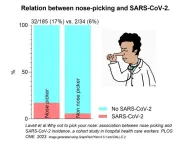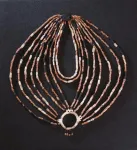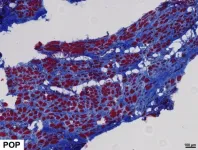(Press-News.org) Patients who live in less affluent neighborhoods and those from underrepresented racial or ethnic groups are less likely than others to receive specialized care for dementia, including Alzheimer’s disease, a new study from Washington University School of Medicine in St. Louis indicates. Further, the research shows that Black people are more likely than white people to be diagnosed with dementia at a later, more advanced stage, which could contribute to inequities in access to new treatments.
The study appears Aug. 2 in the journal Neurology.
New medications to treat early-stage Alzheimer’s recently have emerged. Specifically, aducanumab (trade name Aduhelm) and lecanemab (trade name Leqembi) have been approved for certain patients with early Alzheimer’s disease, which makes the timely diagnosis of Alzheimer’s dementia crucial.
“Dementia care is going through a major transformation right now,” said Suzanne Schindler, MD, PhD, an associate professor of neurology and a co-author of the study. “With these new therapeutics, getting evaluated at a specialty clinic early on — when symptoms first develop — is going to be important in a way that it never was before so that eligible patients can have access to these treatments. Our study suggests that we must seek out ways to ensure that the distribution of these new treatments is equitable.”
The study was focused on the Washington University Memory Diagnostic Center in St. Louis. But identifying a local problem also can shine a light on the national and global problem of socioeconomic and racial disparities in health care and, in particular, Alzheimer’s care. This type of study provides a baseline for measuring the impact of efforts to reduce such disparities in the St. Louis region and more broadly, according to the researchers.
Various forms of dementia can be challenging to diagnose, and most primary care doctors don’t have the detailed information necessary to make, for example, a diagnosis of Alzheimer’s disease. Many such doctors refer patients who may be having memory problems to memory care clinics, where physicians specialize in the evaluation and management of Alzheimer’s disease and other types of cognitive impairment.
Many barriers can impede anyone with symptoms of Alzheimer’s from seeking care and a diagnosis: the requirements for insurance and a primary care provider’s referral, the necessity of a support person — usually a close family member — to accompany a patient to doctor’s visits and help describe their symptoms, the cultural expectations surrounding what constitutes “normal” memory loss, and the list goes on. Even if patients are able to check these boxes, they are often met with discouragingly long wait times for an appointment.
For many reasons, these barriers disproportionately impact individuals from underrepresented groups and people of lower socioeconomic status. This disparate access means that Black patients are less likely to receive a diagnosis of Alzheimer’s disease despite being twice as likely to develop dementia as white Americans.
The study utilized de-identified electronic health record data to compare the socioeconomic status of various neighborhoods where patients lived. Employing a sample of 4,824 Washington University patients from 2008-2018, the researchers evaluated how use of its memory clinic is associated with neighborhood-level measures of socioeconomic factors and race.
The researchers, including first author Abigail Lewis, an informatics doctoral student at Washington University, found that patients at the memory care clinic were more likely to reside in more affluent areas. Black patients were underrepresented, with 11% of clinic patients self-identifying as Black compared with 16% of residents in the area served by the clinic, according to census data. Further, the study showed that Black patients had more advanced dementia than white patients at their initial evaluations. At their first visits, 40% of Black patients and 31% of white patients met criteria for at least mild dementia, and 16% of Black patients and 10% of white patients had moderate or severe dementia.
“While we examined the situation with our patients here at Washington University, this disparity is likely to exist at other facilities nationwide,” said senior author Albert M. Lai, PhD, a professor of medicine in the Division of General Medical Sciences and chief research information officer. “We are hopeful this study can provide information needed to improve equity at Washington University and can provide a starting point to investigate these issues at other specialty memory care clinics across the country.”
These results were not surprising to Schindler or Lai, given that people with a lower socioeconomic status and from underrepresented groups are less likely than others to have health insurance and access to health care, among other barriers.
Still, Schindler said, “having the data that this study provides is compelling. Showing that you can see these disparities in data then gives you the ability to start working toward fixing it.”
Co-author Joyce (Joy) Balls-Berry, PhD, an associate professor of neurology, concurs with the importance of having these numbers and said they provide a renewed chance to consider health disparities moving forward.
Balls-Berry is deeply involved in efforts to address health disparities in memory care. She leads the Health Disparities and Equity Core, which was inaugurated by the Charles F. and Joanne Knight Alzheimer Disease Research Center (ADRC) in 2020 to incorporate principles of diversity, equity and inclusion into all aspects of the Knight ADRC’s work. She said that genuine community engagement is integral to these efforts. Community engagement offers a way to develop relationships with and trust within underrepresented and underresourced communities; it allows for a shared vision to be developed, and for communication between partners to be kept open in both directions.
“Moving forward, we have to be more agile,” Balls-Berry said. “We must continue to emphasize community engagement. I would like to find ways to move beyond having patients come to campus for their care. How do we bring clinical skills to spaces that aren’t clinics, and instead reach out to church communities or child-care facilities, for example, to meet people where they are? Toward better equity, I am interested in seeking ways to work with Dr. Lai’s team to build a process in the electronic health record to identify those patients that are in greatest need of receiving a referral and make sure they get it.”
The researchers suggested some possible interventions to investigate to determine if they move measures of equity in the right direction. Telehealth visits may expand access, as may increasing the number of doctors providing memory care. Another priority of the community is to increase the number of Black doctors providing care. Many times, according to Balls-Berry, patients express a desire to see health-care providers who share their life experiences in terms of gender and race.
“The next steps are always to do more research,” Lai added. “Data contained in the electronic health record is a powerful tool for identifying and monitoring disparities. We now have the opportunity to address them and measure our impact.”
Research and continued community engagement will become more important with each passing day, especially as, in Schindler’s words: “We are now entering this new era where there are treatments available that may have an actual disease-modifying effect on Alzheimer’s disease. This study provides strong evidence that we need change — we want to make our system more equitable in providing these new therapies to those who need them most.”
END
Study defines disparities in memory care
Provides baseline to measure progress toward racial equity in care for Alzheimer’s disease
2023-08-02
ELSE PRESS RELEASES FROM THIS DATE:
New analysis shows surgery is safe and effective for people with unruptured brain arteriovenous malformation
2023-08-02
CONTACT: Camille Jewell
cjewell@vancomm.com or 202-248-5460
SAN DIEGO—Contrary to the results of a seminal study in the field, a recent analysis presented today at the Society of NeuroInterventional Surgery’s (SNIS) 20th Annual Meeting indicates that surgical approaches (embolization, microsurgery, radiosurgery) for treating selected patients with unruptured arteriovenous malformation (AVM) is safe and effective.
AVMs are tangled blood vessels with abnormal connection between arteries and veins, bypassing the capillary ...
Researchers develop smartphone app that reliably recognizes physical signs of stroke
2023-08-02
CONTACT: Camille Jewell
cjewell@vancomm.com or 202-248-5460
SAN DIEGO—Today at the Society of NeuroInterventional Surgery’s (SNIS) 20th Annual Meeting, researchers discussed a smartphone app created that reliably recognizes patients’ physical signs of stroke with the power of machine learning.
In the study, “Smartphone-Enabled Machine Learning Algorithms for Autonomous Stroke Detection,” researchers from the UCLA David Geffen School of Medicine and multiple medical institutions in Bulgaria used data from 240 patients with stroke at four metropolitan stroke centers. Within 72 hours of the ...
Nose-picking healthcare workers were more likely to catch COVID-19 during the pandemic than their colleagues who refrained, per Netherlands cohort study
2023-08-02
Nose-picking healthcare workers were more likely to catch COVID-19 during the pandemic than their colleagues who refrained, per Netherlands cohort study
###
Article URL: https://journals.plos.org/plosone/article?id=10.1371/journal.pone.0288352
Article Title: Why not to pick your nose: Association between nose picking and SARS-CoV-2 incidence, a cohort study in hospital health care workers
Author Countries: The Netherlands
Funding: This work was funded by the Netherlands Organization for Health Research and Development ZonMw (S3 study, grant agreement no. 10430022010023 to M.K.B.) and the Corona ...
Half of popular TikTok videos about Baby Boomers portray older adults negatively, risking reinforcing stereotypes and creating intergenerational conflict
2023-08-02
Half of popular TikTok videos about Baby Boomers portray older adults negatively, risking reinforcing stereotypes and creating intergenerational conflict
###
Article URL: https://journals.plos.org/plosone/article?id=10.1371/journal.pone.0285987
Article Title: Videos about older adults on TikTok
Author Countries: Singapore
Funding: We gratefully acknowledge the support of the Social Science Research Council SSHR Fellowship (MOE2018-SSHR-004). The funders had no role in study design, data collection and analysis, decision to ...
Extreme climates may have driven Middle Pleistocene hominins towards (positive) assortative mating and evolution of bigger brains, according to economic model of climate change impacts
2023-08-02
Extreme climates may have driven Middle Pleistocene hominins towards (positive) assortative mating and evolution of bigger brains, according to economic model of climate change impacts
###
Article URL: https://journals.plos.org/plosone/article?id=10.1371/journal.pone.0287964
Article Title: An economic model and evidence of the evolution of human intelligence in the Middle Pleistocene: Climate change and assortative mating
Author Countries: USA
Funding: The author received no specific funding for this work. END ...
Interest in bird feeding surged in over 100 countries worldwide during the COVID-19 lockdowns
2023-08-02
Interest in local bird feeding appears to have ramped up in countries all over the world during the pandemic lockdowns, even in countries not historically noted for bird feeding practices, according to a study published August 2, 2023 in the open-access journal PLOS ONE by Jacqueline Doremus from California Polytechnic State University and Liqing Li from Texas A&M University College Station, US, and Darryl Jones from Griffith University, Australia.
Feeding wild birds is a popular nature-based pastime because of its simplicity, low cost, and accessibility in even urban environments. ...
Teamwork environments linked to white US employees going the extra mile
2023-08-02
In an analysis of more than 5,000 people, frequently working in teams was associated with a greater tendency for women and white men to put in extra effort at work, while other links between job conditions and effort varied between genders and ethnoracial groups. Wei-hsin Yu of the University of California, Los Angeles, US, and Janet Chen-Lan Kuo of National Taiwan University, Taiwan, present these findings in the open-access journal PLOS ONE on August 2, 2023.
Popular media has recently featured discussion of “quiet ...
Speech deepfakes frequently fool humans, even after training on how to detect them
2023-08-02
In a study involving more than 500 people, participants correctly identified speech deepfakes only 73 percent of the time, and efforts to train participants to detect deepfakes had minimal effects. Kimberly Mai and colleagues at University College London, UK, presented these findings in the open-access journal PLOS ONE on August 2, 2023.
Speech deepfakes are synthetic voices produced by machine-learning models. Deepfakes may resemble a specific real person’s voice, or they may be unique. Tools for making speech deepfakes have recently improved, raising concerns about security threats. For instance, they have already ...
Neolithic necklace from child’s grave reveals complex ancient culture
2023-08-02
A single accessory – an ornate necklace from a child’s grave in ancient Jordan – provides new insights into social complexity of Neolithic culture, according to a study published August 2, 2023 in the open-access journal PLOS ONE by Hala Alarashi of the Consejo Superior de Investigaciones Científicas, Spain, and the Université Côte d’Azur, France and colleagues.
Body adornments are powerful symbols that communicate cultural values and personal identities, and they are therefore highly valuable in the study of ancient cultures. In this study, Alarashi and colleagues analyze materials that adorned ...
New insights on pelvic floor damage after vaginal birth, and new directions for treatment
2023-08-02
In the August 02, 2023 issue of Science Translational Medicine, University of California San Diego researchers lead a team that has published new insights on pelvic floor muscle (PFM) dysfunction, which is one of the key risk factors for pelvic floor disorders, a set of morbid conditions that include pelvic organ prolapse and urinary and fecal incontinence, that impact close to a quarter of women in the U.S. and have a strong association with vaginal childbirth. The work is part of a larger effort to advance understanding, treatment and prevention of pelvic floor muscle dysfunction in humans.
The ...
LAST 30 PRESS RELEASES:
Fame itself may be critical factor in shortening singers’ lives
Daily coffee drinking may slow biological ageing of people with major mental illness
New highly efficient material turns motion into power – without toxic lead
The DEVILS in the details: New research reveals how the cosmic landscape impacts the galaxy lifecycle
After nearly 100 years, scientists may have detected dark matter
Gender imbalance hinders equitable environmental governance, say UN scientists
Six University of Tennessee faculty among world’s most highly cited researchers
A type of immune cell could hold a key to preventing scar tissue buildup in wounds
Mountains as water towers: New research highlights warming differences between high and low elevations
University of Tennessee secures $1 million NSF grant to build semiconductor workforce pipeline
Biochar shows powerful potential to build cleaner and more sustainable cities worldwide
UT Health San Antonio leads $4 million study on glucagon hormone’s role in diabetes, obesity
65-year-old framework challenged by modern research
AI tool helps visually impaired users ‘feel’ where objects are in real time
Collaborating minds think alike, processing information in similar ways in a shared task
Routine first trimester ultrasounds lead to earlier detection of fetal anomalies
Royal recognition for university’s dementia work
It’s a bird, it’s a drone, it’s both: AI tech monitors turkey behavior
Bormioli Luigi renews LionGlass deal with Penn State after successful trial run
Are developers prepared to control super-intelligent AI?
A step toward practical photonic quantum neural networks
Study identifies target for disease hyper progression after immunotherapy in kidney cancer
Concordia researchers identify key marker linking coronary artery disease to cognitive decline
HER2-targeted therapy shows promising results in rare bile duct cancers
Metabolic roots of memory loss
Clinical outcomes and in-hospital mortality rate following heart valve replacements at a tertiary-care hospital
Too sick to socialize: How the brain and immune system promote staying in bed
Seal milk more refined than breast milk
Veterans with cardiometabolic conditions face significant risk of dying during extreme heat events
How plants search for nutrients
[Press-News.org] Study defines disparities in memory careProvides baseline to measure progress toward racial equity in care for Alzheimer’s disease






